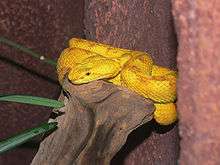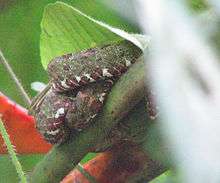Bothriechis schlegelii
| Bothriechis schlegelii | |
|---|---|
.jpg) | |
| Scientific classification | |
| Kingdom: | Animalia |
| Phylum: | Chordata |
| Subphylum: | Vertebrata |
| Class: | Reptilia |
| Order: | Squamata |
| Suborder: | Serpentes |
| Family: | Viperidae |
| Subfamily: | Crotalinae |
| Genus: | Bothriechis |
| Species: | B. schlegelii |
| Binomial name | |
| Bothriechis schlegelii (Berthold, 1846) | |
| Synonyms | |
| |
Bothriechis schlegelii, the eyelash viper, is a venomous pit viper species found in Central and South America. Small and arboreal, this species is characterized by a wide array of color variations, as well as the superciliary scales above the eyes. It is the most common of the green palm-pitvipers (genus Bothriechis),[2] and is often present in zoological exhibits. The specific name schlegelii honors Hermann Schlegel, who was a German ornithologist and herpetologist.[3] For other common names see below. No subspecies are currently recognized.[4]
Description
.jpg)

The eyelash viper is a relatively small species of pitviper, with adults ranging from 55–82 cm (22–32 in) long, and females being longer and more variable in size than males, which can grow to 69 cm (27 in) long.[5] It has a wide, triangular-shaped head, and eyes with vertical pupils. Like all pit vipers, it is solenoglyphous, having large, hypodermic needle-like fangs in the front of the upper jaw that fold back when not in use, and has heat sensitive organs, or pits, located on either side of the head between the eye and nostril.
Its most distinguishing feature, and origin of its common name, is the set of modified scales above the eyes that look much like eyelashes. The eyelashes are thought to aid in camouflage, breaking up the snake's outline among the foliage where it hides. B. schlegelii occurs in a wide range of colors, including red, yellow, brown, green, even pink, as well as various combinations thereof. It often has black or brown speckling on the base color. No external features distinguish the two sexes.[6]
Common names
Common names of B. schlegelii include the eyelash viper,[7] eyelash pit viper, eyelash palm viper, eyelash palm-pitviper,[8][6] Schlegel's viper,[7] Schlegel's pit viper,[9] Schlegel's palm viper,[10] eyelash snake,[2] eyelash lancehead,[11] eyelash mountain viper,[7] and horned palm viper.[2] In Spanish, the primary language of countries comprising its distribution, common names include bocaracá,[12] oropel (golden morph),[12] víbora bocaracá, toboba pestanas,[6] víbora de pestañas[8] (eyelash viper), and serpiente loro[8] (parrot snake).
Geographic range
The geographic range of B. schlegelii extends from southern Mexico (northern Chiapas), southeastward on the Atlantic plains and lowlands through Central America to northern South America in Colombia and Venezuela. It is also found on the Pacific versant and lowlands in parts of Costa Rica, Panama, Colombia, Ecuador and Peru. It occurs in mesic forest at elevations almost from sea level to 2,640 m (8,660 ft) altitude. The type locality is “Popayan” (Popayán, Colombia).[1]
Habitat
B. schlegelii prefers lower altitude, humid, tropical areas with dense foliage, generally not far from a permanent water source.[13] One study noted the preference of B. schlegelii for deep, shady ravines.[14]
Behavior

Like other Bothriechis members, B. schlegelii is arboreal and has a strong prehensile tail. It is largely nocturnal, consuming small rodents, frogs, lizards and small birds.[5] It is not known to be an aggressive snake, but will not hesitate to strike if harassed.
A typical ambush predator, it waits patiently for unsuspecting prey to wander by. Sometimes, it is known to select a specific ambush site and return to it every year in time for the spring migration of birds. Studies have indicated that B. schlegeli learns to improve strike accuracy over time. Sometimes B. schlegelii (especially juveniles) will employ what is known as “caudal luring”, wiggling the tail in worm-like motions to encourage potential prey to move within striking range.
There is a myth among villagers in some small areas of South America that the eyelash viper will wink, flashing its eyelashes at its victim, following a venomous strike. Snakes are not physiologically capable of such behavior, as they have no eyelids and can not close their eyes.[15]
Reproduction
The eyelash viper reaches sexual maturity at around two years of age, and the ovoviviparous species reproduces throughout the year in warm environments.[5] Females carry eggs for around six months before they hatch internally, where the young complete their development.[5] Pregnant females have enlarged lower abdomens, and may stop eating in later stages of pregnancy.[5] In a typical brood they give birth to 2–20 live young, which are 15–20 cm (5.9–7.9 in) in length and appear physically similar to adults.[5]
Males engage in a sometimes hours-long courtship ritual called a "dance of the adders", in which two males posture and intimidate one another in an upright, "cobra-like" stance until one is pushed away or falls to the ground.[5] They are polygynous, and usually mate at night.[5]
Captivity
Despite the inherent danger of its venom, B. schlegelii is frequently available in the exotic animal trade, and is well represented in zoos worldwide. It is frequently captive bred for color and pattern. Exporting from the wild is not as common as it once was, but is not unknown. In general they make hardy captives, readily feeding on provided mice.
Taxonomy
Some authorities also recognize a montane form that is treated either as a subspecies (B. s. supraciliaris) or as a species (B. supraciliaris).[7] Found in the province of San José in Costa Rica,[16] it was sometimes referred to as the eyelash mountain viper,[7] while more recent publications recognizing the species designation refer to it as the blotched palm-pitviper.[17][18]
Conservation
Eyelash vipers have not been evaluated by the IUCN Red List, and were removed from CITES Appendix III in 2002.[5] While not listed as threatened, they are likely at risk of habitat loss from increased deforestation for timber, agriculture, and urbanization.[5]
See also
- List of crotaline species and subspecies
- Crotalinae by common name
- Crotalinae by taxonomic synonyms
- Snakebite
References
- 1 2 McDiarmid RW, Campbell JA, Touré TA (1999). Snake Species of the World: A Taxonomic and Geographic Reference, Volume 1. Washington, District of Columbia: Herpetologists' League. 511 pp. ISBN 1-893777-00-6 (series). ISBN 1-893777-01-4 (volume).
- 1 2 3 Lewis, Robert Alan (23 March 1998). Lewis' Dictionary of Toxicology. CRC Press. p. 187. ISBN 978-1-56670-223-2.
- ↑ Beolens, Bo; Watkins, Michael; Grayson, Michael (2011). The Eponym Dictionary of Reptiles. Baltimore: Johns Hopkins University Press. xiii + 296 pp. ISBN 978-1-4214-0135-5. (Bothriechis schlegelii, p. 235).
- ↑ "Bothriechis schlegelii ". Integrated Taxonomic Information System. Retrieved 4 June 2007.
- 1 2 3 4 5 6 7 8 9 10 Sinnett, Katy. "ADW: Bothriechis schlegelii information". Animal Diversity Web. University of Michigan Museum of Zoology. Retrieved 9 January 2014.
- 1 2 3 Guyer, Craig; Donnelly, Maureen A. (2005). Amphibians and Reptiles of La Selva, Costa Rica, and the Caribbean Slope: A Comprehensive Guide. University of California Press. p. 165. ISBN 978-0-520-93701-7.
- 1 2 3 4 5 Mehrtens, John M. (1987). Living Snakes of the World in Color. Sterling Pub. Co. ISBN 978-0-8069-6460-7.
- 1 2 3 "Common Names for Eyelash Palm Pit Viper (Bothriechis schlegelii )". Encyclopedia of Life. Retrieved 9 January 2014.
- ↑ Parker HW, Grandison AGC (1977). Snakes -- A Natural History. Second Edition. British Museum (Natural History) and Cornell University Press. 108 pp. 16 plates. LCCCN 76-54625. ISBN 0-8014-1095-9 (cloth), ISBN 0-8014-9164-9 (paper),
- ↑ Brown JH (1973). Toxicology and Pharmacology of Venoms from Poisonous Snakes. Springfield, Illinois: Charles C. Thomas. 184 pp. LCCCN 73-229. ISBN 0-398-02808-7.
- ↑ Wrobel, Murray (4 December 2004). Elsevier's Dictionary of Reptiles. Elsevier. p. 73. ISBN 978-0-08-045920-2.
- 1 2 Henderson, Carrol L. (30 November 2010). Mammals, Amphibians, and Reptiles of Costa Rica: A Field Guide. University of Texas Press. p. 150. ISBN 978-0-292-78464-2.
- ↑ Sorrell, Geoffrey G. (2009-02-12). "Diel Movement and Predation Activity Patterns of the Eyelash Palm-Pitviper (Bothriechis schlegelii )". Copeia. 2009 (1): 105–109. doi:10.1643/CE-06-284. ISSN 0045-8511.
- ↑ Nations, James D. (2006). Maya Tropical Rainforest. Austin: University of Texas Press. p. 72. ISBN 9780292712829.
- ↑ Goin CJ, Goin OB, Zug GR (1978). Introduction to Herpetology, Third Edition. San Francisco: W.H. Freeman and Company. xi + 378 pp. ISBN 0-7167-0020-4. ("Snakes ... glassy, unwinking glare", p. 53).
- ↑ "Facts about Bothriechis supraciliaris". Encyclopedia of Life. Retrieved 9 January 2014.
- ↑ O'Shea, Mark (March 2008). Venomous Snakes of the World. New Holland Publishers. p. 41. ISBN 978-1-84773-086-2.
- ↑ Lillywhite, Harvey B. (April 2014). How Snakes Work: Structure, Function and Behavior of the World's Snakes. Oxford University Press. p. 25. ISBN 978-0-19-538037-8.
External links
| Wikimedia Commons has media related to Bothriechis schlegelii. |
- Bothriechis schlegelii at the Reptarium.cz Reptile Database. Accessed 12 December 2007.
- Eyelash viper at WhoZoo. Accessed 27 November 2008.
- Eyelash pit viper. Accessed 27 November 2008.
